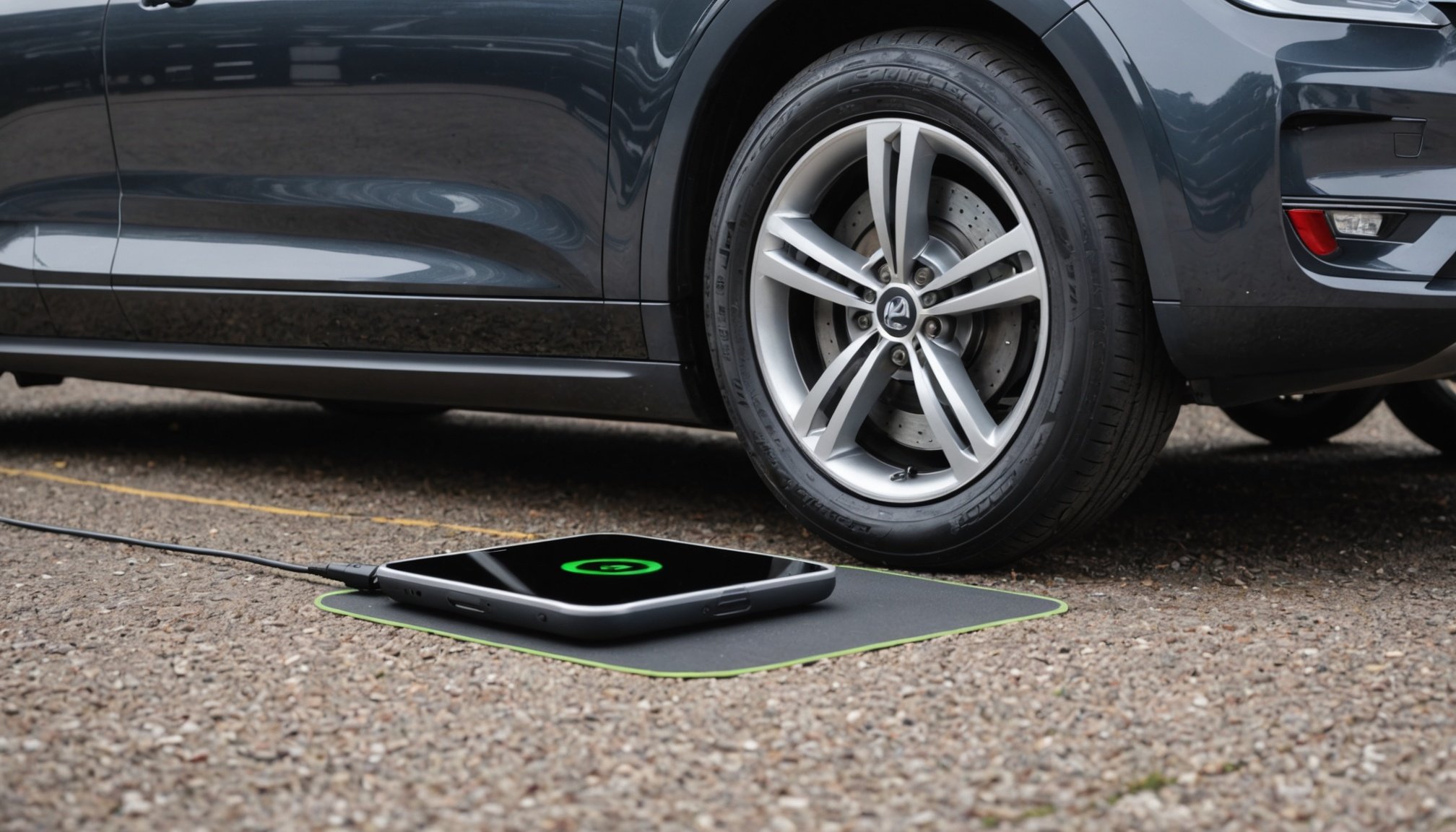Overview of Wireless Charging for Electric Vehicles
Wireless charging for electric vehicles is a transformative technology that promises greater convenience and efficiency. At the core of this system lies the wireless charging pad, which employs electromagnetic induction to transfer energy between two connected objects. This means electric vehicles can be charged without physical connectors, streamlining the entire process.
The benefits of integrating a wireless charging pad into British electric vehicles are significant. Firstly, it eliminates the hassle of plugging and unplugging charging cables, saving time and reducing wear on connectors. Secondly, it enhances safety by reducing trip hazards associated with traditional cables, offering peace of mind to users. Additionally, these wireless systems can be installed in diverse locations, such as driveways or parking garages, making them versatile for home or public use.
Also to read : Transforming Your British Classic Car: A Step-by-Step Guide to Upgrading with a Modern Infotainment System
When comparing traditional charging methods to wireless charging, the latter shines in terms of convenience and ease of use. Traditional methods, while effective, often involve cumbersome cables, which can be difficult to handle, particularly in poor weather conditions. Wireless charging, on the other hand, allows for effortless charging by simply parking over the pad, thus making it a more intuitive choice for those seeking seamless electric vehicle ownership.
Necessary Tools and Materials for Installation
When preparing for the installation of an electric vehicle charging station, having the right tools and materials is crucial. For a successful setup, you’ll need a basic toolkit, including a drill, voltage tester, and wire strippers. Additionally, ensure your toolset includes a socket set and a cable cutter. These tools are essential for handling various tasks, from drilling holes to securing cables.
Additional reading : Transform Your British Sedan: A Comprehensive Guide to Installing a Panoramic Sunroof
Next, consider the materials vital for compatibility with British electric vehicles. Use durable, weather-resistant wiring and conduits to ensure safety in different temperatures and conditions. It’s also wise to select connectors that support high voltages common in British standards, to cope with fluctuating power demands.
The importance of high-quality components can’t be overstated. Quality materials not only ensure a reliable installation but also reduce future maintenance needs. Using substandard items may lead to inefficiencies, such as power loss or the risk of electrical faults. Opting for premium products from reputable manufacturers helps avoid these pitfalls and secures the longevity of your installation.
- Essential tools: drill, voltage tester, wire strippers
- Recommended materials: weather-resistant wiring, compatible connectors
- High-quality components critical for efficiency and safety
Step-by-Step Installation Process
Proper installation of a wireless charging pad in your vehicle enhances convenience. Here’s how you can do it efficiently.
Preparing the Vehicle
Before you begin, secure a safe workspace. Park your vehicle on level ground and engage the emergency brake. Gather necessary tools like screwdrivers and wire cutters. Ensuring safety is paramount. Remember to disconnect the battery’s negative terminal to prevent any electrical mishaps during installation.
Mounting the Wireless Charging Pad
Positioning the charging pad requires precision. First, identify a location within your vehicle that allows easy access and doesn’t hinder driving. Common spots include the armrest or the dashboard. Ensure the surface is clean and dry. Use adhesive or screws, depending on the pad’s design and vehicle material, to firmly secure it. Each vehicle’s specifications may differ, requiring adjustment in techniques.
Connecting the Charging Pad to Power
Establishing electrical connections is crucial. Locate the power source that suits your car’s circuit. Often, tapping into the fuse box is recommended for a reliable connection. Use an appropriate gauge wire to connect the pad, ensuring no frayed ends or loose connections. Using a multimeter can help verify a stable power supply, avoiding disruptions and ensuring your charging pad functions optimally.
Compatibility Considerations with British Electric Vehicles
Understanding the compatibility of charging solutions with British electric vehicles is crucial for both current and prospective EV owners. With various vehicle models on the market, it’s important to ensure that their charging pads align well with desired specifications. Each vehicle model may have distinct compatibility needs based on its design and the battery type. Compatibility can also be influenced by the charging infrastructure’s specifications, including connector types and charging speeds.
Local Regulations and Standards
British regulations play a significant role in dictating which installation choices are viable for electric vehicle owners. The Office for Low Emission Vehicles (OLEV) provides guidelines ensuring that installations meet environmental and safety standards, influencing the compatibility of systems. Further, certain localities might enforce stricter regulations, requiring homeowners to adhere to specific standards when choosing and installing a charging solution.
Recommendations
Before investing in a charging system, it’s recommended to check compatibility between your vehicle and the charging pad. Be guided by the vehicle manufacturer’s specifications or consulting with certified installers who are familiar with British standards. Doing so can prevent unnecessary costs and ensure optimal performance. Understanding and confirming compatibility can lead to a smoother and more efficient charging experience, leaving you with one less worry while transitioning to a more sustainable form of transportation.
Troubleshooting Common Installation Issues
Installation hiccups can be frustrating, but knowing the common problems and solutions helps. Often, issues arise from misaligned components or software conflicts. Ensure all hardware is securely connected and software requirements are met before proceeding.
If persistent installation issues occur, check for driver updates or potential compatibility problems with your operating system. Sometimes, a simple reboot or reinstall can solve a significant problem. Testing the system after installation is essential to ensure everything functions correctly. Run diagnostics or use built-in troubleshooting tools to identify any lingering issues.
Another typical problem is incorrect configuration settings, which can cause operational hitches. Double-check the configuration settings to confirm they match the product instructions. If the system still isn’t working as expected, consider looking into error codes or messages that might illuminate the root cause.
However, if problems persist despite all efforts, don’t hesitate to seek professional help. Expert technicians can provide insights and fixes that might not be apparent to the average consumer. It’s better to invest in professional assistance than let an unresolved issue escalate. Remember, a smooth installation sets the foundation for optimal performance, making it crucial to address every problem promptly and effectively.
Tips for Optimal Charging Performance
to maintain optimal charging efficiency, it is essential to adopt a few performance tips. Begin with ensuring that the charging pad is free from any dust or debris, which can affect its performance. Regular cleaning can prevent overheating, a common issue affecting charging speeds. While dusting may seem trivial, it plays a significant role in maintaining efficiency.
It is equally crucial to regularly check that your charging equipment is functioning correctly. Loose cables or damaged plug pins can disrupt power flow, affecting charging efficiency. Thus, running routine inspections can save you from unexpected slowdowns.
Environmental factors cannot be overlooked when considering charging performance. For instance, placing charging pads in areas prone to direct sunlight or extreme cold could hinder their capability to charge devices efficiently. It is advisable to position your charging setup in moderate temperature settings to enable consistent performance.
Furthermore, using recommended manufacturer cords and chargers can prevent potential damage and maintain optimal charging. These accessories are designed specifically for the devices, ensuring compatibility and better energy transfer.
By implementing these practices, you can prolong your device’s battery life, prevent inefficient charging, and ensure consistently optimal device performance over time.
FAQs about Wireless Charging Installation
When considering the installation of wireless charging solutions, FAQs often emerge concerning the process and support involved. A common query is, “What is the general process for installing wireless charging pads?” The installation typically involves selecting a compatible surface for the pad, ensuring proximity to a power source, and following the manufacturer’s instructions meticulously to avoid complications. For many, this might seem daunting, but most solutions come with comprehensive guides and customer support to assist users through each step.
Another frequent query revolves around warranties and service support. “What kind of warranty is typically offered for wireless charging pads?” Most manufacturers provide a one-year warranty, although some may extend this period based on the product tier or purchase agreement. It’s vital to check individual product warranties as they can vary.
For those in need of additional resources, manufacturers’ websites or customer service lines often offer further assistance and detailed information. Many services also provide installation guides and troubleshooting FAQs, making it easier for users to resolve issues independently. Utilizing these resources can greatly enhance the setup experience, ensuring a seamless transition to using wireless charging technology effectively.











